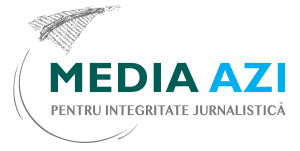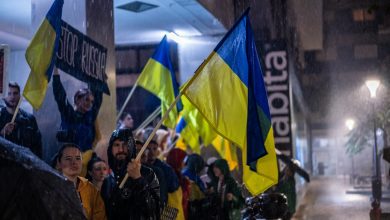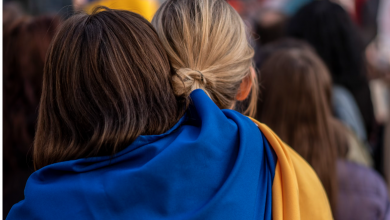Irene Scott, humanitarian community engagement expert at Internews: The media needs to make sure it talks about people, not labels. Being a refugee does not fully define a person

The armed conflict in Ukraine and the increased flow of refugees who have arrived in Moldova from the neighboring state have created a series of challenges, including for the media, which has to report daily on these topics. What is the role of the press during a war? How should reporters talk to refugees? How can we address the authorities’ response to such a crisis? But also, how do we, as journalists, manage the traumas that we might face as a result of the work we do? These and other questions were answered by Irene Scott, Senior Humanitarian Community Engagement Project Manager at Internews, who was present on April 1 at an informal meeting at the School of Journalism in Moldova.
Media Azi: What do you think is the role of reporters during times of crisis, like the war in Ukraine?
Irene Scott: Reporters have a big role to play in the crisis in Ukraine. In general, there are several roles to play when there is something in the public interest that the community needs to know about. On the first hand, of course, the role is to report what is happening and to report it from the Moldovan perspective, highlighting the issues that are important to the community here. But I think they also have a really big role to play in terms of how the crisis is perceived – which stories they choose to highlight, how they choose to talk about the refugee population, about the impact that it might be having on Moldova, and the humanitarian response as well. All of these things play a really big role in how the situation is perceived and what information the community has in order to decide what to do next. Everyone in Moldova, in one way or another, is affected by this crisis.
So, I think it’s really important for journalists to listen to their community, hear their questions and their complaints, but also find a way to translate what’s happening and help them understand this humanitarian response and all of the new organizations that have now come to Moldova. Journalists can explain how their mandates work, how decisions are taken about who gets aid and who doesn’t, but also hold those humanitarian organizations to account. Reporters that interact with refugees directly should also have a list of useful resources and organizations that could help guide those in need.
Media Azi: During the meet-up organized by the Moldova School of Journalism, you also mentioned that the local media should give a voice to refugees. What are some of the ways in which media organizations could engage with the new audience?
Irene Scott: Over time, it’s going to be an important goal to engage with them. Most of the newly arrived people from Ukraine are probably getting their news from Ukrainian media, their friends, and their family. If they stay in Moldova longer, they will need to access local information that is also for them. And so, the media can help by thinking about what their information needs are. It would be great to start looking at ideas for co-creating media content. Whether that’s a radio program that is hosted by someone from Ukraine and someone from Moldova, or co-written TV programs and articles. In this way, the media involves the community and allows refugees to tell their own stories, so they have a lot more ownership over them. These steps are also helpful in fighting the stereotypes or assumptions that might start to creep in.
Media Azi: Considering what you have seen so far in the media, have you noticed some common mistakes outlets and reporters make when engaging with the humanitarian response?
Irene Scott: I understand that as a journalist, it’s really appealing to go and take photos and interview people in refugee centers just as they’ve arrived. I understand that this is where you get a very emotional, very interesting story for your listeners. Something for journalists to keep in mind is to think about the state of mind that people arriving might be in, people who have just suffered something quite traumatic, and try to be respectful of that person. Allowing them to decide whether they do or don’t feel like being interviewed at that time. Trying to keep in mind that places like the refugee centers are someone’s home. Being respectful of the dignity of that person who maybe doesn’t want their photo being taken in that environment, maybe there’s another security concern that they have. Reporters should be careful and get consent before publishing photos, especially of children, but of any refugees in this situation, because there might be a really good reason as to why they don’t want their photo on the front page of a newspaper or the front page of an online website.
Media Azi: Almost half of the refugees arriving are minors. What are some other specific rules for interviewing them?
Irene Scott: It’s difficult for a child to consent to an interview because they need to understand what an interview is, and what the implications of agreeing to one are. A child might not comprehend the bigger picture of what it means for their name and their story to be potentially broadcast all around the world. Before you think about talking to a child or even photographing a child, you would ideally speak to their parents first, and then with the child as well. If there isn’t a parent with the child, then you should connect with an NGO or volunteers working with the community and talk to them first. Make sure they’re with you when you interview a child. It is difficult for minors to know what information is OK to share and what can present security risks for them, for example. So be very careful. Journalists should also check UNICEF’s strong guidelines regarding photographing children.
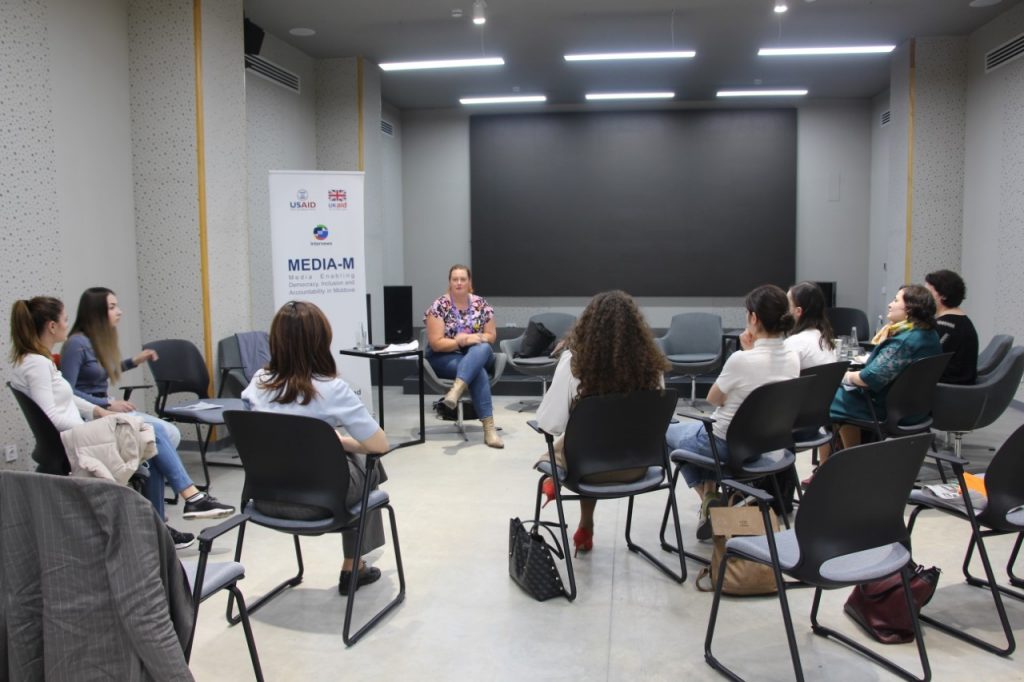
Media Azi: Could you elaborate a bit about the giving and obtaining of consent when interviewing and reporting on the crisis?
Irene Scott: Consent entails having a discussion with that person and recognizing that they hold some power in this situation, instead of walking up to someone with a microphone already on, or the camera already rolling or taking a photo as you’re talking to them straight away. By saying hi, introducing who you are, explaining what your article is about, as it is really important for them to have context of what they’re agreeing to and what kind of story they might be involved in. Ask if they feel comfortable talking and having their name mentioned. Make sure that the person knows that at any stage of the interview they can choose to change their mind and end it. Reporting on the refugee crisis might be new for the journalists here, but also being a refugee is really new for the people that have just arrived. They might not have had a lot of interaction with the media before, and they certainly might not have been interviewed at a time when they’re particularly vulnerable. So, it’s really good to let them know that they always hold the power in the interview. Because the last thing you want to do as a journalist is to get someone’s story but further traumatize them in the process.
Media Azi: What about the terminology used by the media when referring to the people arriving from Ukraine? During the meet-up, local reporters admitted that they are confused about choosing the appropriate terms in their materials.
Irene Scott: I think journalists should ask the people that have arrived recently from Ukraine how they prefer to be named. They would prefer not to be referred to as refugees. They might prefer to be referred to as guests, people from Ukraine. The challenge is that, in some contexts, refugee might be the right word to use. It’s always good to ask the person and to think about the audience that you’re speaking to. A bigger debate, I guess, within journalism itself, is to think about what it is about the term “refugee”, and how media might have potentially contributed to negative feelings towards this term in the past. I think media around the world had a role to play in creating stereotypes and shaping how people feel about refugees. That’s contributing quite a lot to the hesitation of some newly arrived people from Ukraine who might prefer not to be called a refugee. The media should make sure that they’re always talking about a person. At the end of the day, the first thing they are is a person, not just a label. Being a refugee is not their entire identity.
Media Azi: The concept of vicarious trauma was also mentioned during the event. Can you maybe elaborate on what it is and how it can affect journalists?
Irene Scott: Vicarious trauma is the concept that even though the challenging experience did not happen directly to you, hearing the stories of people who have been through trauma impacts you as well. And as a journalist you might spend all day talking to refugees, telling you really difficult stories about what they’ve been through to survive, to come here. And that does put weight on your shoulders. There are people that have suffered serious effects of trauma without being involved in the firsthand trauma. Reporters should acknowledge the pressure and find someone to speak to, find a release for all of that tension that they’re taking on through that process. It can really have long-term effects on you.
Sometimes, within a newsroom, there isn’t the culture of feeling comfortable saying: “Actually, I’m not doing so well”, “Reporting on this has been really hard. I’m feeling the effects”. It’s something that needs to be tackled at multiple levels. The individual needs to look out for the signs that they might be feeling this additional stress and trauma, but then the managers of newsrooms need to think about the impact on their staff and look for ways to provide support. Employees should know that it’s OK to say they’re not feeling OK or that they need a break or they need to talk to someone.
There are several small steps that can be taken. There are helpful resources, especially on the DART Center for Journalism and Trauma website. The management can make it really clear by sending an email or mentioning the topic during meetings, to destigmatize mental health discussions and make people comfortable about sharing their feelings. That’s a simple thing that costs nothing. Journalists should look out for colleagues if they’re noticing that someone is reacting a lot faster, or jumping to anger. Noticing personality changes, like having a short fuse or becoming a lot quieter. Then having a chat with them and asking about their feelings about what they are working on. So, looking out for your friends and colleagues. And then, from there, it’s a question of whether the journalist feels that they are suffering vicarious trauma and want to reach out to a psychologist. Or whether they want to look at some resources online, go for a run, do yoga or do something physical. Everyone’s way of releasing stress is different. Generally, it is important to make sure that there’s an awareness of mental health issue.
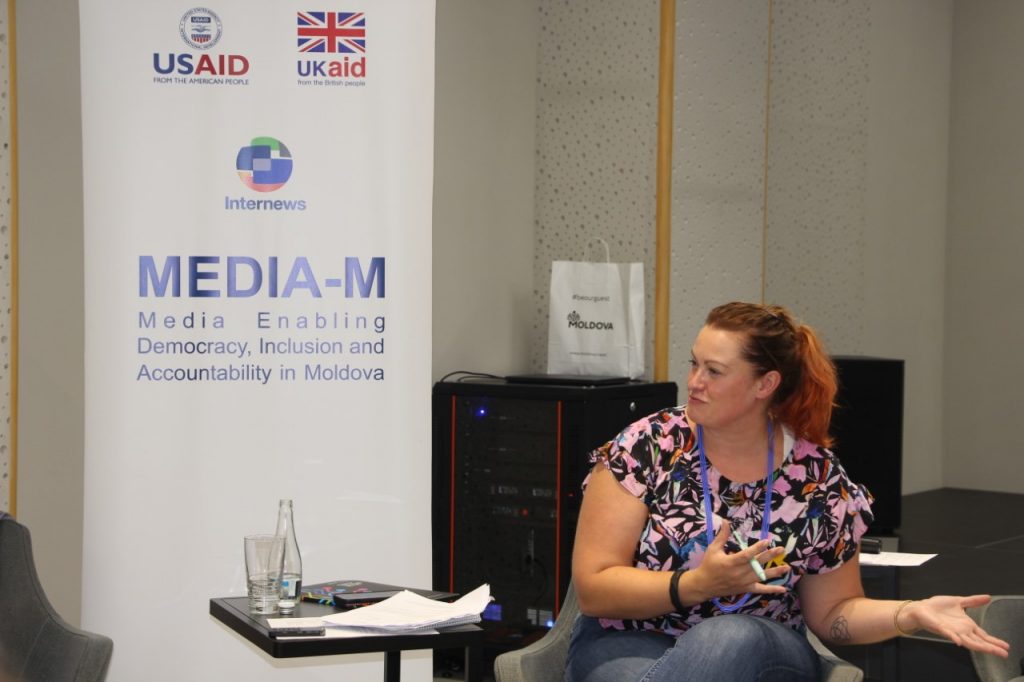
Media Azi: From the experience of Rooted in Trust, a project focused on debunking misinformation, could you tell what some of the effective methods and tools to fight fake news and disinformation are? In Moldova, we have struggled with the quality of information circulating during the pandemic, and now the war in Ukraine proves to be another challenge.
Irene Scott: Especially during a crisis, when emotions and stress are high, research shows that people are faster to share information without checking it first. The media has a massive role to play in fighting the misinformation that will be circulating during this war. I think a huge source of misinformation is really people who have genuine questions and concerns and want access to really accessible information in languages and formats that they prefer, that they can really use to answer their questions. As soon as people feel silenced, that’s when they stop listening to the media. I would argue that one thing that the media could really do is make sure that there are really clear channels for their audience to ask questions and get answers. They might be using social media platforms to have direct conversations with the community. Identifying something as a rumor and saying this is false is really just the first step in that process. Perhaps a more effective way to fight disinformation is to think about what its drivers are. Is there a historical distrust of authority? The media should take a bit more thought and address a rumor in a holistic way, rather than just pinpointing whether something is true or false.
Media Azi: You have experience working in countries affected by conflict or natural disasters. What do media organizations struggle with months after a humanitarian crisis starts?
Irene Scott: Certainly, one of the issues that the media already faces is the drop in ad revenue. That’s something that donors and organizations can help with. Another big challenge is the decline in interest in these topics. After a few months of reporting on the Ukraine war and the refugee influx in the region, there’s pressure coming from the audience and the editors to move on to something new. But this humanitarian crisis will develop and it’s the role of journalists to keep going back to make sure that it is covered properly. So, they need to fight for space and make sure that the big issues are highlighted.
The COVID-19 crisis taught us how to sustain a story, but also how to think about the secondary impacts of something like that. When you’re reporting on a pandemic, it’s not just about the figures of how many people have COVID-19 or how many took a test. That is only the start of the story. Secondary impacts like elective surgery or shortage of workforce need to be reflected as well. In the current case of the humanitarian crisis in Moldova, the media should map out the potential impacts a large influx of refugees will have. Who are the different stakeholders impacted by this crisis? Having an extra 100,000 people in the country is not something that has no impact. Reporters should also keep in mind that some of the effects will be positive.
It is also important to look at the relationship between humanitarian agencies and the media. It can be difficult for reporters to sum up really big, important issues with a small amount of airtime or lines. So, sometimes oversimplification happens and that annoys humanitarian organizations and then distrust can breed. Building and maintaining these relationships and the trust between these entities over time is crucial. But also, as I mentioned before, the media should hold these NGOs accountable.
